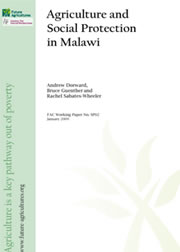{jathumbnail off} This paper reviews social protection and agriculture policies in Malawi in order to explorethe links, synergies and conflicts that lie between them. It begins with brief backgroundinformation about Malawi, in terms of its economic and welfare indicators.
This paper reviews social protection and agriculture policies in Malawi in order to explorethe links, synergies and conflicts that lie between them. It begins with brief backgroundinformation about Malawi, in terms of its economic and welfare indicators.
Particularemphasis is placed on understanding agricultural and social protection policies within thecontext of
(a) political issues and
(b) market and livelihood development.
This is followed witha review of agricultural and social protection policies, their interactions and their impacts onlivelihoods and welfare. Specific attention is given to evolving input subsidy policies whichare of particular relevance to this review. We conclude with a discussion of lessons that canbe learned from Malawian experience with agriculture and social protection.
Before examining specific agricultural and social protection policies in terms of their evolutionand outcomes, it is important to place these in context. We focus on three particular (andinter-related) aspects of context, the political context (as this affects the policy choices thatpoliticians make), the economic context (as this affects the policy demands, resources andhence options), and the agricultural and rural livelihood context (as this affects the policydemands and policy outcomes).
A broad historical understanding is critical in understandingthese contexts, and table 1 sets out major pertinent events since 1990/91. The Economic Context With more than 55% of its rural population in poverty and 24% ultra-poor in 2004/5(National Statistical Office, 2005, and GNI per capita of around 170 US$, Malawi is oneof the poorest countries in the world, as evidenced by a range of social and economic indicators. Many people in Malawi are characterized by high levels ofvulnerability, due to the fragility of their livelihoods, susceptibility to shocks, and largenumbers of non-poor people living just above the poverty line (Devereux et al., 2006).
